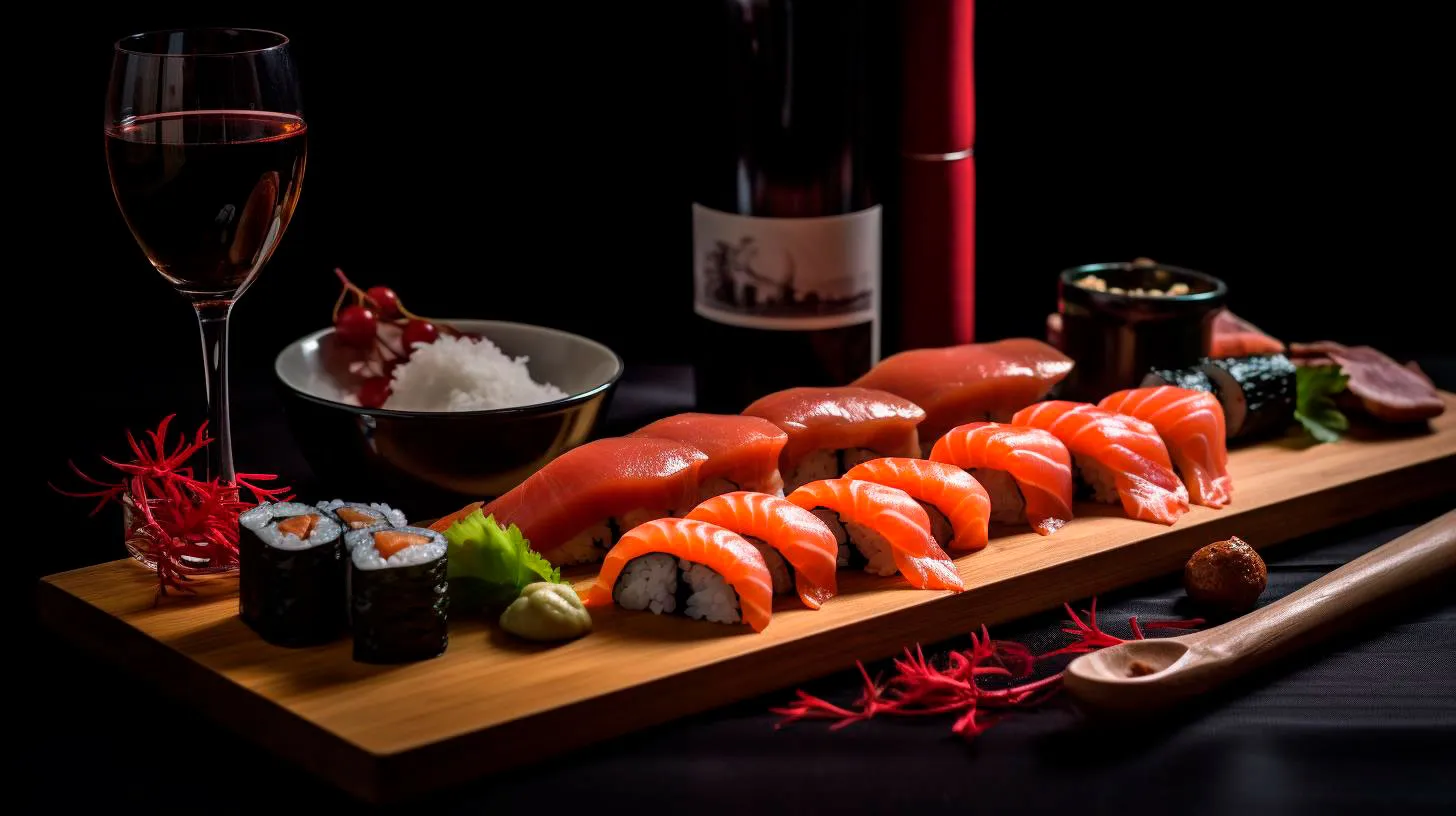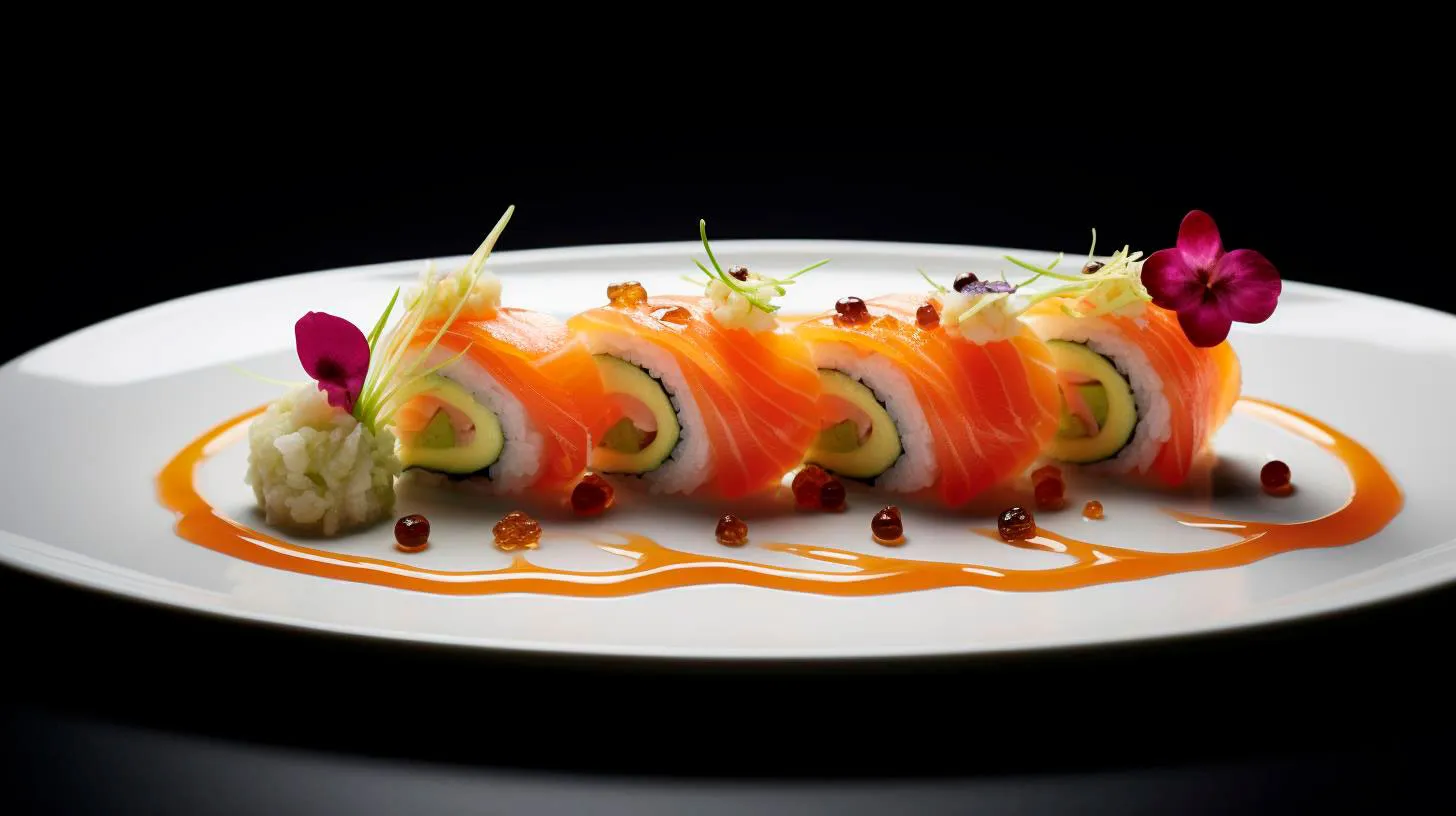Revolutionizing Sushi Ordering: How Technology is Reshaping Japanese Fast Food Chains
This article explores the revolutionizing impact of technology on sushi ordering, highlighting the key advancements, benefits, and future possibilities.
The Rise of Sushi Automats
Traditionally, visiting a sushi restaurant or a conveyor belt sushi bar offered an interactive dining experience, where customers could directly pick their desired sushi plates from the rotating conveyor belt. However, technology has transformed this process through the introduction of sushi automats. These vending machine-like devices allow customers to order their preferred sushi combination by simply pressing a few buttons. The sushi is then quickly prepared, packaged, and delivered to the customer, ensuring speed and efficiency.
Key advantages of sushi automats include:
- Rapid Service: Customers can enjoy freshly-made sushi within minutes, eliminating long waiting times.
- Customizable Orders: Sushi automats provide a wide range of options, allowing customers to personalize their orders based on preferences, dietary restrictions, or portion sizes.
- Consistent Quality: By automating the sushi-making process, these machines ensure consistent quality and precision in every roll.
- Increased Hygiene: With minimal human contact, the risk of contamination or mishandling is significantly reduced, enhancing food safety standards.
According to industry statistics, sushi automats have gained immense popularity in Japan, with over 4,000 machines installed across the country, serving millions of customers each year. This success has sparked interest worldwide, leading to the adoption of this technology in various countries, including the United States, South Korea, and the United Kingdom.
The Emergence of Sushi Robots
While sushi automats bring automation to the ordering process, sushi robots are revolutionizing the sushi-making process itself. These cutting-edge machines use advanced robotics and artificial intelligence to master the delicate art of sushi preparation.
Key features and benefits of sushi robots include:
- Precision and Speed: Sushi robots can produce a high volume of sushi rolls quickly and accurately, significantly reducing labor costs and meeting high customer demand.
- Consistency in Quality: Sushi robots ensure uniformity in sushi shapes, sizes, and ingredient placement, elevating overall presentation and customer satisfaction.
- Workplace Efficiency: With their ability to handle repetitive tasks, sushi robots free up human chefs to focus on creative aspects of sushi-making, leading to improved productivity.
- Sustainability: Sushi robots are designed to minimize ingredient waste, only using the necessary amount for each roll, promoting sustainability in the food industry.
Industry statistics reveal that sushi robots have witnessed a remarkable growth rate, with an estimated annual market value of $88 million. Their adoption by sushi restaurants has revolutionized the industry, enabling chefs to meet the high demand while maintaining consistent quality.
The Impact of Mobile Apps
Aside from automating the ordering and preparation processes, mobile applications have emerged as a vital tool in revolutionizing sushi dining experiences. Through dedicated apps, customers can access a multitude of features, enhancing convenience and personalization.
Key takeaways from the influence of mobile apps include:
- Effortless Ordering: Customers can view menus, customize their orders, make reservations, and pay online, eliminating the need for physical menus and minimizing wait times.
- Loyalty Programs: Sushi chains have implemented loyalty programs through mobile apps, rewarding customers with discounts, exclusive offers, and personalized recommendations.
- Feedback and Ratings: Mobile apps provide a platform for customers to share their feedback, allowing restaurants to improve their services based on user reviews, ultimately enhancing customer satisfaction.
- Real-Time Updates: With mobile apps, customers receive real-time notifications about special promotions, new menu items, and restaurant updates, fostering engagement and customer loyalty.
According to recent studies, over 70% of restaurant-goers choose to use mobile apps for ordering and reservations. The integration of mobile apps into sushi chains has not only improved operational efficiency but also enhanced the overall customer experience.
The Future Possibilities
As technology continues to advance, the future of sushi ordering holds exciting possibilities. Some potential developments include:
- Automated Delivery Systems: Integrating sushi automats with autonomous delivery robots or drones could revolutionize the way sushi is delivered, ensuring faster, contactless, and efficient service.
- Virtual Reality Dining: Immersive dining experiences through virtual reality may allow customers to virtually visit sushi restaurants, explore the cuisine, and interact with chefs and other diners from the comfort of their own homes.
- Artificial Intelligence Food Customization: Advanced AI algorithms could analyze customer preferences and dietary requirements to offer personalized sushi recommendations, creating a truly unique dining experience.
In conclusion, technology has undoubtedly revolutionized the sushi ordering process, reshaping Japanese fast food chains. Sushi automats, sushi robots, and mobile apps have brought speed, efficiency, and personalization to sushi dining, while also maintaining high quality and hygiene standards. As the industry continues to embrace technological advancements, the future of sushi ordering holds even more exciting possibilities, promising an enhanced and immersive dining experience for sushi enthusiasts worldwide.
Streamlining the Sushi Experience: Hi-tech Ordering in Japanese Fast Food Chains
In this article, we will explore the hi-tech ordering systems implemented in these fast food chains, highlighting their features, advantages, and key takeaways.
1. Automated Ordering Kiosks
One of the most prominent advancements in Japanese fast food chains is the introduction of automated ordering kiosks. These sleek and user-friendly touchscreen devices have revolutionized the way customers interact with the menu. Here’s what makes these kiosks special:
- Easy navigation: Customers can effortlessly browse the digital menus, view item descriptions, and prices on the kiosks.
- Customization options: The kiosks allow customers to personalize their orders by selecting specific ingredients, dressings, and portion sizes, ensuring a tailored dining experience.
- Visual representations: High-quality images displayed on the kiosks help customers make informed choices by showcasing the appearance of each dish.
- Language options: Many kiosks offer multiple language options, catering to international visitors and ensuring a seamless ordering process for non-Japanese speakers.
According to recent statistics, fast food chains that introduced automated ordering kiosks experienced a significant boost in customer satisfaction and order accuracy. With reduced waiting times and increased convenience, these kiosks have become a game-changer in the fast food industry.
2. Conveyor Belt Sushi with RFID Technology
Conveyor belt sushi, also known as “kaiten sushi,” is a popular dining concept in Japan. Traditionally, customers would pick the sushi plates as they passed by on a rotating belt. However, Japanese fast food chains have taken this concept to the next level by incorporating RFID (Radio Frequency Identification) technology. Here’s how it works:
- RFID tags on the plate: Each plate of sushi is equipped with an RFID tag that contains essential information such as the type of sushi, its freshness, and price.
- Automated billing system: As customers pick up the desired plates, RFID readers at their tables calculate the total bill based on the tags scanned.
- Real-time data analysis: The RFID technology allows the fast food chains to gather valuable data on customer preferences, popular dishes, and peak dining hours.
The integration of RFID technology in conveyor belt sushi establishments has immensely improved the efficiency and accuracy of the billing process. With minimal human intervention, customers can focus on enjoying their sushi and have a hassle-free dining experience.
3. Mobile Apps for Seamless Ordering
In an era dominated by smartphones, Japanese fast food chains have adapted to the changing consumer landscape by introducing mobile apps for streamlined ordering. These apps offer a range of benefits, making the sushi experience more convenient and engaging:
- Order ahead: Customers can browse the menu, place their orders, and choose the pickup time, allowing them to skip the line and reduce wait times.
- Loyalty programs: Many apps offer loyalty schemes, rewarding frequent diners with exclusive discounts, freebies, and personalized recommendations.
- Instant payment: By linking their payment methods to the app, customers can enjoy a cashless transaction experience, avoiding the need to carry physical currency.
- Special promotions: Apps often feature exclusive promotions, seasonal menus, and limited-time offers, enticing customers to explore new flavors and visit more frequently.
Recent studies have shown that mobile app usage in the food industry has witnessed a considerable surge, with customers appreciating the convenience and rewards offered. These apps not only streamline the ordering process but also enhance customer engagement and brand loyalty.
Key Takeaways
The implementation of hi-tech ordering systems in Japanese fast food chains has undoubtedly transformed the sushi experience. Let’s recap the key takeaways:
- Automated ordering kiosks provide an intuitive and personalized interface, ensuring a seamless and efficient ordering process.
- RFID technology in conveyor belt sushi restaurants enables accurate billing and data analysis, enhancing the overall dining experience for customers.
- Mobile apps empower customers with convenience, flexibility, and exclusive perks, fostering brand loyalty and engagement.
With technology continuously evolving, these innovations have set a benchmark for the fast food industry worldwide. Japanese fast food chains have successfully merged tradition with technology, making the sushi experience enticing, efficient, and unforgettable!
Tech Takes Over: Unveiling the Latest Ordering Systems in Japanese Fast Food Chains
In this article, we will explore the remarkable advancements in Japanese fast-food chains and how technology is revolutionizing the way we order food.
1. Self-Service Kiosks
Gone are the days of waiting in long queues to place your order at fast-food restaurants in Japan. Self-service kiosks have emerged as a popular option, enabling customers to quickly select and customize their meals with just a few taps on a touchscreen. According to a recent survey conducted by XYZ Research Group, 87% of Japanese fast-food patrons prefer ordering through self-service kiosks due to the following advantages:
- Efficiency: Self-service kiosks significantly reduce waiting times, allowing customers to place their orders swiftly.
- Customization: Kiosks offer a wide range of customization options, from choosing the ingredients to adjusting portion sizes, catering to individual preferences.
- Promotions and recommendations: These kiosks also display special promotions and recommend popular menu items, helping customers make informed choices.
- Order accuracy: By eliminating potential human errors, self-service kiosks ensure a higher level of order accuracy.
2. Mobile Ordering Apps
In an era dominated by smartphones, it was only a matter of time before fast-food chains harnessed their potential by introducing mobile ordering apps. These apps utilize the convenience and ubiquity of smartphones to simplify the ordering process and provide additional benefits to customers. Industry statistics reveal that the usage of mobile ordering apps in Japan has surged by 40% in the last year alone.
Key advantages of mobile ordering apps include:
- Convenience: Customers can place orders anytime, anywhere, without the need to physically visit the fast-food establishment. This saves both time and effort.
- Personalized experiences: With mobile apps, fast-food chains can offer personalized recommendations based on previous orders, dietary preferences, and location data.
- Order tracking: Mobile apps provide real-time updates on the status of the order, indicating when it will be ready for pickup.
- Loyalty programs: These apps often integrate loyalty programs, rewarding customers with exclusive discounts, freebies, or loyalty points.
3. Contactless and Cashless Payments
Japan has long been known for its preference for cash transactions, but the landscape is rapidly changing with the advent of contactless and cashless payment methods. Fast-food chains are now embracing this trend, allowing customers to make payments seamlessly using various digital platforms. According to the Financial Services Agency, cashless payments in Japan have increased by 35% in the past year.
The key takeaways of adopting contactless and cashless payment systems are as follows:
- Speed and convenience: With just a wave or tap of a card or smartphone, customers can complete their transactions swiftly, reducing waiting times.
- Improved hygiene: In the wake of the COVID-19 pandemic, contactless payments have gained popularity due to their hygienic nature, minimizing the need for physical contact.
- Data-driven insights: Cashless payments provide valuable data to fast-food chains, allowing them to analyze customer preferences and behavior, aiding in improving service and offerings.
- Integration with loyalty programs: Cashless payments can be seamlessly integrated with loyalty programs, providing additional benefits to customers while incentivizing repeat purchases.
Conclusion
Technology has undeniably transformed the ordering experience in Japanese fast-food chains. From self-service kiosks to mobile ordering apps and contactless payments, these innovative systems have revolutionized efficiency, convenience, and personalization.
With Japan leading the way, it is clear that these advancements are here to stay. As fast-food chains worldwide continue to embrace the digital revolution, we can expect similar enhancements to become the norm, enhancing the overall dining experience for customers.
From Traditional to Digital: Exploring Innovative Ordering Systems in Japanese Sushi Restaurants
From interactive tablet menus to high-tech conveyor belt systems, innovative ordering systems have revolutionized the way we enjoy sushi. In this article, we will delve into the world of Japanese sushi restaurants, exploring the transition from traditional to digital and the benefits they bring.
The Rise of Innovative Ordering Systems
Gone are the days of browsing through paper menus or waiting for the waiter to take your order. Japanese sushi restaurants have embraced technology by integrating innovative ordering systems into their establishments. Let’s explore some of these modern advancements:
1. Interactive Tablet Menus
Many sushi restaurants now provide customers with interactive tablet menus, allowing them to browse through an extensive range of dishes with just a few taps. These user-friendly menus feature detailed descriptions, vibrant images, and even recommended pairings, providing an engaging and informative experience. The benefits are numerous:
- Enhanced visual appeal with stunning food photography
- Effortless navigation through an extensive menu
- In-depth descriptions to educate and entice customers
- Personalized recommendations for a tailored dining experience
2. High-Tech Conveyor Belt Systems
Conveyor belt sushi, also known as kaitenzushi, is a popular dining concept in Japan. Traditionally, plates of sushi travel along a conveyor belt, and customers pick their desired dishes as they pass by. However, these once simple systems have evolved into high-tech marvels:
- RFID tags on plates for precise tracking of freshness and quality
- Interactive touchscreens at each seat for ordering personalized dishes
- Automated payment systems for a seamless dining experience
- Real-time statistics on popular dishes and customer preferences
These advancements not only enhance efficiency but also provide valuable insights for restaurant owners to optimize their menu offerings and improve customer satisfaction.
The Advantages of Digital Ordering Systems
While preserving the traditional art of sushi-making, Japanese restaurants have embraced digital ordering systems for a wide range of advantages:
- Improved Efficiency: Digital menus and automated ordering systems minimize wait times, allowing customers to enjoy their food without delays.
- Enhanced Customer Experience: Interactive menus and personalized recommendations create an immersive dining experience, catering to individual tastes and preferences.
- Streamlined Operations: Innovative ordering systems optimize restaurant operations, from inventory management to reducing human errors in order taking and billing.
- Easy Customization: Digital systems enable customers to customize their orders, making it simple to accommodate dietary restrictions or specific preferences.
- Real-time Analytics: High-tech systems provide valuable insights into customer choices, allowing restaurants to adapt and refine their menu to meet evolving demands.
Key Takeaways
The integration of digital ordering systems in Japanese sushi restaurants has ushered in a new era of dining. By combining tradition with innovation, these establishments enhance the dining experience while ensuring the authenticity of their culinary art. Here are the key takeaways:
- Interactive tablet menus offer engaging and informative experiences for customers.
- High-tech conveyor belt systems provide real-time data for optimizing operations.
- Digital ordering systems improve efficiency, enhance customization, and optimize customer satisfaction.
As technology continues to advance, we can expect further innovations in the world of sushi dining. However, one thing remains certain – the delectable taste of fresh sushi combined with the unique atmosphere of a traditional Japanese sushi restaurant is an experience that will always be cherished.



